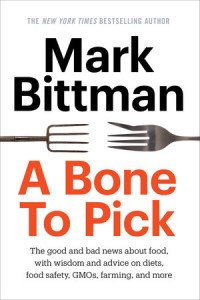Archive for October 2015
Food Writer/Activist Mark Bittman Speaks at Albany’s Writers Institute
 The insightful New York Times food writer, recipe guru, and activist Mark Bittman, as part of the Writers Institute’s speakers series (founded by William Kennedy, Albany’s famed novelist in 1983), spent an afternoon last week at a recital hall on the campus of the State University of Albany and explained how he “accidentally” became a food writer. He also gave generously of his time and voice to answer, sometimes acerbically, questions from an eager audience of students, faculty, and fans of his cookbooks and newspaper columns, who all seemed to share his strong opinion that Americans need to “eat more food from the plant kingdom.” According to Mr. Bittman, success for him would be to “get every American to eat rice and beans” at least once a week.
The insightful New York Times food writer, recipe guru, and activist Mark Bittman, as part of the Writers Institute’s speakers series (founded by William Kennedy, Albany’s famed novelist in 1983), spent an afternoon last week at a recital hall on the campus of the State University of Albany and explained how he “accidentally” became a food writer. He also gave generously of his time and voice to answer, sometimes acerbically, questions from an eager audience of students, faculty, and fans of his cookbooks and newspaper columns, who all seemed to share his strong opinion that Americans need to “eat more food from the plant kingdom.” According to Mr. Bittman, success for him would be to “get every American to eat rice and beans” at least once a week.
Later on the same day, Mr. Bittman appeared at a downtown Albany auditorium before another friendly crowd at a “conversation” about cooking, recipes, food policy and his books (including his latest, A Bone to Pick, The good and bad news about food, with wisdom and advice on diets, food safety, GMOs, farming, and more (Pam Krauss Books, imprint of Crown Publishing Froup, a Division of Penguin Random House, New York, NY, 2015) with Steve Barnes, a popular local reporter, restaurant and theater reviewer, and blogger for the Albany Times Union.
The Vegan Before 6:00PM (VB6) advocate came to Albany as a result of his long friendship with Donald Faulkner, the Director of the New York State Writers Institute. Faulkner and Bittman, as writers (post-college), shared an office in the late 1970s at Yale New Haven Hospital, and under the guidance of Eugene Cooney, a newspaper man, wrote hospital stories for modest compensation, in an attempt to reinvent the hospital’s in-house magazine. Bittman’s appearance in Albany represented a “reunion” with Faulkner to celebrate the spirit of Eugene Cooney with a memorial lecture, which turned out to be more of a probing Q and A session on food topics and the unexpected path Mr. Bittman took in becoming a well-compensated and popular food writer.
Some luck and good timing had much to do with Mark Bittman (whose first freelance piece was on the subject of glue for Popular Mechanics) becoming the well-regarded food writer. During a karate class in 1979 at the ripe age of 29, Mr. Bittman learned of the opportunity to earn $50 for writing theater and restaurant reviews for the New Haven newspaper. With these writing clips, Bittman could call himself a “writer.” After tiring of writing restaurant reviews in the New Haven area, he found satisfaction in the late 80s “teaching people how to cook” through his now proven, and compensated, writing ability. This eventually led to his becoming editor of Cook’s Magazine and subsequently a food writer for the New York Times. When the Times started its Dining section, a relaunching of an earlier Living section, Bittman’s weekly column, The Minimalist, in the new section of the newspaper became very popular with readers.
Mr. Bittman’s succinct answer on the best way to improve America’s food system consisted of three excellent points: (1) control the marketing of food to children; (2) eliminate antibiotics from the food supply; and (3) cook for yourself. According to the Public Health Law Center at the William Mitchell College of Law, the Federal Trade Commission (FTC) reported that in 2009, food and beverage companies spent $1.79 billion to market their products to kids. Seventy-two percent of this total was spent to market just three types of products—breakfast cereals, fast foods, and carbonated drinks. We have previously reported on actions taken by the Federal Drug Administration (FDA) to control the unsafe use of antibiotics in animal feed. Bittman’s third point to “cook for yourself” has also been vigorously made by Michael Pollan in his Food Rules: Rule 82, “Cook,” is short and sweet. According to Pollan, “Cooking just might be the single most important thing you can do for your dietary health . . . Cooking for yourself is the only sure way to take back control of your diet from the food scientists and food processors, and to guarantee you’re eating real food rather than edible foodlike substances, with their unhealthy oils, high-fructose corn syrup, and surfeit of salt.”
Later in the evening, a challenging question was posed by Robert Jones, the President of SUNY-Albany, who holds a doctorate in crop physiology. Although unable to be present at Mr. Bittman’s conversation with Steve Barnes, the university president’s question was relayed to Mr. Bittman for his response: “What is the best way to end world hunger?” In this era when companies like Monsanto and Cargill contend that only industrial agriculture practices can “feed the growing world’s population,” Mr. Bittman’s answer was appreciated: “End world hunger, by ending world poverty.” He elaborated further by pointing out that small scale farming uses 30% of the world’s agricultural resources to feed 70% of the world’s population while industrial agriculture uses 70% of the world’s agricultural resources to feed 30% of the world’s population. His column in the New York Times from a couple of years ago, How to Feed the World (10/14/13), elaborates further on this important point. Mr. Bittman shares a similar position articulated by Maria Rodale in her Organic Manifesto (Rodale, Inc. [distributed to the trade by Macmillan], New York, New York, 2010), reviewed earlier on this website.
One question Mr. Bittman did not answer, which was posed twice in the course of his day in Albany, was the name of his new employer. In his “last regular opinion column on food” for the New York Times, A Farewell, he explained he wanted “to try to change the world, not just write about it” and was taking “a central role in a year-old food company . . . to make it easier for people to eat more plants.” Mr. Bittman’s fans and readers will have to wait a bit longer for this information.
Frank W. Barrie, 10/27/15
[Editor’s note: A week or so after Mark Bittman’s appearance at the Writer’s Institute in Albany, the New York Times reported that he “is joining the Purple Carrot, one of the many new meal kit delivery services that have sprung up over the last several years.” Reporter Stephanie Strom noted that “The Purple Carrot is a vegan version of subscription meal kit services like Plated, Blue Apron, Green Chef and HelloFresh.”
South Pond Farms’ Flavorful Celery Root & Leek Soup, Sweetened Subtly With A Pear
Celery Root & Leek Soup
Danielle French, a creative chef and the owner of South Pond Farms in the Kawartha Lakes area of Ontario, about 75 minutes from Toronto, has shared a favorite soup recipe that eases the chill of autumn. With its deeply rich celery taste, this hearty and creamy soup has a pure vegetable flavor. Danielle suggests serving the soup with a crusty bread (in the Toronto area, the Blackbird Baking Company has a prominent spot in our craft bakery directory) and a glass of white wine.
South Pond Farms, a popular venue for weddings with its picturesque barn, fields and pond, offers a lunch table open to the public on Wednesdays during May to September and a four course supper on the last Thursdays of the month from May to October. In addition, brunches with classical music are regularly scheduled throughout the year; cooking classes and workshops drawing together artisanal food, art and culture are also offered at the farm.
1 T butter or olive oil
In a heavy saucepan, melt the fat and add the leeks. Turn the heat to medium low and sauté the leeks until tender about 10 minutes.
Add the celery root, pear and chicken broth and bring to a boil. (Celery root and apple is also a great combination and an apple can be substituted for the pear in this recipe; Early macs or cortlands are a good apple variety to use.) Simmer for about 15-20 minutes until the celery root is tender and then add the parsley.
Turn the heat off and let cool slightly. Purée the soup with a blender or hand-held immersion blade until smooth.
Season with pepper and salt to taste. Serve with a dollop of cream or yogurt (in Ontario, Best Baa Dairy Yogurts is included in our farmstead and artisinal yogurt directory).
This simple soup of celery root and leek is delicious with just these two special ingredients with the celery root lending creaminess and depth of flavor, but this recipe can also be used as a soup base to which other vegetables are added. For example, increase the broth component by 1 – 2 cups and add 2 cups of diced carrots or squash.
[Editor’s note: We take special pleasure to promote opportunities for a diner to enjoy a meal at a farm.
In addition to our listing of South Pond Farms in the dining directory for Ontario, our dining listings include a number of listings worth special attention: In the Vermont dining directory, Cloudland Farm in North Pomfret (Windsor County); in the New Hampshire dining directory, the Hilltop Café at the Temple Wilton Community farm, one of the oldest CSAs in the country in Wilton (Hillsborough County), and Ariana’s Restaurant at Bunken Farm in Orford (Grafton County); in the Maine dining directory, Flanagan’s Table in Buxton (York County), Wolfe’s Neck Farm in Freeport (Cumberland County) and Graze at Pineland Farms in New Gloucester (Cumberland County); in the Massachusetts dining directory, Just Right Farm in Plympton (Plymouth County); in the New York dining directory, Dancing Ewe in Granville (Washington County), Fable at Stone & Thistle Farm in East Meredith (Delaware County) and the Bees Knees Café at Heather Ridge Farm in Preston Hollow (Albany County); in the Virginia dining directory, The Restaurant at Patowmack Farm in Lovettsville (Loudon County); in the Ohio dining directory, the Malabar Farm Restaurant in Lucas (Richmond County); in the Indiana dining directory, The Loft Restaurant in Zionsville (Boone County); in the California dining directory, Farmstead at Long Meadow Ranch in St. Helena (Napa County); and in the Arizona dining directory, The Farm at South Mountain offers 3 dining options, The Farm Kitchen, Morning Glory Café and Quiessence in Phoenix. FWB]
Dartmouth Ranked #1 for College Food in Sierra Magazine’s 2015 Rankings
Dartmouth College earned an impressive 49.89 out of a possible score of 51 in Sierra Magazine’s 2015 Cool Schools ranking in the food category to lead the list of 153 “four-year, degree-granting undergraduate colleges and universities in the United States.” The top ten for college food include schools in diverse eastern and western locations, but none in the American heartland or the southern states:
| Rank | School | 51 (Possible Score) |
| 1 | Dartmouth (Hanover, NH) | 49.89 |
| 2 | Sterling College (Craftsbury Common, Vt) | 47.00 |
| 3 | U C Berkeley (Berkeley, Calif) | 43.00 |
| 4 | Villanova (Villanova, Pa) | 42.83 |
| 5 | Columbia U (NYC, NY) | 42.71 |
| 6 | Univ of Washington (Seattle, Wa) | 42.01 |
| 7 | Chatham Univ (Pittsburgh, Pa) | 41.53 |
| 8 | Stanford (Palo Alto, Ca) | 41.04 |
| 9 | Carnegie Mellon (Pittsburgh, Pa) | 40.89 |
| 10 | Portland State U (Portland, Or) | 39.63 |
Sierra’s “Cool Schools Scoring Key 2015” includes nearly 70 thoughtful and detailed criteria underlying the “scoring basis” and the number of specific points obtainable for each criteria. The possible score of 51 in the food category was based on these criteria: (1) 30 points, food and beverage purchasing policies, with institutions earning 1/3 of available points (10 points) by calculating the percentage of food expenditures that are local and community-based, or are third-party-certified responsible (certified organic, fair trade, etc.) and they also “earn a portion of the remaining 2/3 [20 points] based on that percentage;” (2) 7 points, pre consumer food waste composting; (3) 7 points, post consumer food waste composting; and (4) 7 points, vegan options. Seven points were allocable to organic garden, with institutions earning “all available points for having one or more programs that allow students to gain experience in organic agriculture and sustainable food systems.” However, these points were for a criteria included in the “full ranking” noted below and apparently not considered in ranking schools in the food category, although there is discretion in the scoring in the “food and beverage purchasing policies” criteria noted above. Perhaps in determining 20 of those allocable 30 points, food sourced at a school café from a farm or garden on campus resulted in some extra points when such discretion was exercised.
The “Full Ranking” in determining “America’s Greenest Universities” was based on all 70 criteria with a potential score of 1000. Some of the criteria with the most potential points were energy consumption in buildings, 40 points; support for clean and renewable energy, 45 points; water consumption, 40 points, and storm water management, 40 points. The ten greenest schools include six large public universities (including three campuses of California’s state university system) and 3 small liberal arts colleges. Only the University of Washington in Seattle was ranked in the top ten in both the food category, detailed above and the full ranking based on all criteria, noted below:
| Rank | School | 1000 (Possible Score) |
| 1 | U C Irvine (Irvine, Calif) | 867.29 |
| 2 | U C Davis (Davis, Calif) | 787.46 |
| 3 | Univ of Wisconsin-Oshkosh | 786.91 |
| 4 | Colorado State Univ (Fort Collins, Co) | 782.90 |
| 5 | Middlebury College (Middlebury, Vt) | 779.08 |
| 6 | Oberlin College (Oberlin, Ohio) | 775.95 |
| 7 | U C San Diego (San Diego, Calif) | 766.77 |
| 8 | Univ of Connecticut (Storrs, Ct) | 766.30 |
| 9 | Lewis & Clark College (Portland, Or) | 762.55 |
| 10 | Univ of Washington (Seattle, Wa) | 761.70 |
For the 2015 rankings, Sierra received 153 complete responses from qualified colleges, which do not have to pay to participate. Sierra ranks schools on greenness with the “hope” that its annual ranking will “act as a guide for prospective students who want to compare colleges based on the schools’ commitment to environmentalism.” Further, Sierra contends that its ranking “also serves to spur productive competition between colleges, raise eco-standards on campus and publicly reward the institutions that work hard to protect the planet.”
For the 2014 rankings, which were reported earlier on this website, 173 schools, or 20 more schools participated last year than in 2015. In the food category, four of the schools included in the top ten for 2105 were also in the top ten schools for food in 2014: University of Washington, Villanova, Carnegie Mellon and U C Berkeley.
All of the colleges and universities that choose to participate in the annual Sierra rankings deserve praise for demonstrating to their students that they care about environmental sustainability and they “honor their students’ idealism by committing to the planet’s big issues” in the words of Sierra’s Lifestyle Editor, Avital Andrews. Sadly, the number of schools participating should be increasing, not decreasing by 20 as occurred this year. If your school has opted out of participating or has never participated, students, alum and concerned citizens should contact the institution’s sustainability coordinator or public relations office and ask them to participate. Click here to see if your college and university is among the schools participating. The completed survey for each of the 153 school that participated are available by clicking on the name of the particular school in the Sierra rankings.
Frank W. Barrie, 10/11/15
Breakfast in Brooklyn: Brunching on Food From egg’s Own Upstate NY Farm
In an airy, sun-filled dining room in the heart of Brooklyn, there’s a place in the popular Williamsburg neighborhood where you can revel in the simplicity of a homey, country meal. And if breakfast is your thing, you’re in luck, because egg serves it all day. But don’t let the name fool you: eggs are just the beginning of the story.
George Weld, egg’s founder, grew up in the south and, because he modeled many of the restaurant’s signature dishes on childhood faves, the fare at egg is decidedly southern. The raw ingredients, on the other hand, are mostly from the north (about 140 miles north to be precise). Taking farm-to-table a step further than most restaurants touting local sourcing of food, egg sources many of its fruits and veggies (plus flowers) from its Goatfell Farm in Oak Hill, a hamlet in the town of Durham (Greene County, NY) in the shadow of the northern Catskill Mountains. And what they don’t grow themselves, they get mostly from other small family farm growers and producers.
Having such fresh ingredients at their fingertips, egg’s cooks focus their menu on what’s in season and just harvested. But the reason behind establishing egg’s own farm goes deeper: Weld started the farm so his staff could take turns working on the farm and get to know the foods they’re using on a whole new level. His master plan seems to be working: egg’s dishes are a testament to a faith in the goodness of simply prepared food when the source and freshness of the ingredients is known from personal experience on the farm. How wonderful and rare for restaurant workers to “plant, tend and harvest” the food they make and serve. Adding to this wonder, George Weld’s restaurant is in New York City, the most intensely urban place in the U.S. (where “nature deficit disorder” is not an unknown diagnosis for many of its inhabitants).
Visiting the restaurant on a weekend, when egg’s menu shifts to a more brunch-oriented affair, the line was, not surprisingly, out the door. The wait gave me a chance to plan my order from the deceptively simple menu. I say “deceptively” because the magic of everything I ordered was rooted in the depth of its quality, not its complexity. No fancy claims or exotic ingredients here and to expect it would be unfair. But when you have as much control over your ingredients as egg does, dishes that normally play supporting roles become shining stars on their own.
Take egg’s bacon. The medium-thick strips from Heritage Foods USA (a Brooklyn distributor of heritage breed meats of all kinds and which lists on its website the family farmers “raising livestock with old-school genetics on pasture” who supply the meats it sells) were both crispy and chewy, with fat that was neither shriveled nor dense: a delicate and difficult balance that a regular bacon eater notices immediately.
Elemental quality also shined through with egg’s biscuits and sawmill gravy. With a heavy dose of fresh black pepper dominating the palate initially, I only noticed the mildly fennel-laced sausage (made in house) as an afterthought. But the more I ate, it dawned on me that this subtle one-two punch really keeps things exciting. The buttermilk biscuits (made with local organic flour and Hudson Valley’s Ronnybrook Farm Dairy butter and milk) were dry but not tough—perfect for withstanding the gravy’s moist embrace. If the gravy hadn’t been as thick as it was, I’m sure I would have drunk the stuff.
Less stunning, but no less satisfying, were the organic pancakes with maple syrup courtesy of Northeastern Vermont’s eminently sustainable Deep Mountain Maple. At first, I felt a little cheated for getting pancakes that weren’t the decadent creations my imagination had conjured. But after digging in, I had to admit they were great—just the way I’d cook them myself (if I was actually any good at it). It didn’t hurt that the maple syrup was incredibly delicious: lightly sweet with pleasant notes of cinnamon, vanilla, and malt.
Since I didn’t order one of the egg-based mains on tap (they typically offer the tempting eggs Rothko, described as “easy-cooked eggs” in a slice of brioche topped with Grafton cheddar, a cheddar omelet made with broiled tomatoes, grits and eggs, chorizo and eggs, and French toast), I ordered scrambled eggs as a side just to see what all the noise of the other contented diners was about. I was not disappointed. This simple preparation of the namesake ingredient was expertly performed. The quality of the eggs (sourced from hens raised on local grains like alfalfa and flax at Columbia County’s fourth-generation Feather Ridge Farm) was obvious from the bright yellow hue of the yolk. Their rich flavor only needed the gentle lift of freshly ground black pepper to emerge.
Since it was brunch and I was in a celebratory mood, I indulged in both the bloody mary (very tomatoey, with some kind of pickled onion, leek or garlic scape but wasn’t quite sure) and the grapefruit mimosa (albeit non-local grapefruit). I’ve had a few bloody marys in my day and know what I like, and I can tell you egg’s delivered on all counts. The main thing was that it sported an unusually solid balance. No thrown together watery store mix with cheap vodka: this drink was thick, lemony, and savory—without the typical untamed blast of spicy horseradish. With its house-made pickled garnish and gentle spiciness, it was clearly the creation of a connoisseur. For its part, the mimosa’s fresh grapefruit juice imbued it with a flavor that made the concoction resemble a fizzy Sauvignon Blanc. No joke.
And that brings me to the surprising ending to the meal (in addition to a delicious blackberry grunt, much like a fruit cobbler): the caramelized grapefruit with mint. I’d never had nor heard of this treat before, but let me tell you: a baked grapefruit is something you need to try (even in northern climes) immediately. I was a little skeptical when I saw the dish arrive hot, not cold, figuring that I would be getting a freshly sliced grapefruit with some kind of quickly flamed sugar or honey on the top. Instead, the lightly charred turbinado surface came curling in onto a surface sprinkled with desiccated mint leaves. When I tried it, the revelation that passed through my lips is best described as what you’d expect if mojitos were some sort of food, rather than drinks. Needless to say, this manna didn’t last long and my skepticism was gone. I have a hunch that the wait, on a line out the door, to dine at egg is here to stay.
egg (Brooklyn), 109 North 3rd Street (between Berry & Wythe Streets in Williamsburg), 718.302.5151, Breakfast (served all day): Mon-Fri 7:00AM-5:00PM, Sat-Sun 8:00AM-5:00PM, Lunch: Mon-Fri 11:30AM-5:00PM, Sat & Sun 3:00PM-5:00PM www.eggrestaurant.com
Matt Bierce (10/5/15)
[Editor’s note: A few miles further west from egg’s Goatfell Farm in Oak Hill is Heather Ridge Farm (a farm, farm store and café) in Preston Hollow which operates the Bees Knees Café, on the farm. Its farmhouse dining room has spectacular views of the high peaks of the Catskill Mountains. Reviewed previously on this website, nearly four years ago, it should be noted that the cafe has extended its operation to year-round from a more seasonal operation. The Bees Knees Café expands the experience of dining on a farm fresh breakfast to brunch on the farm, and like breakfast at egg, also highly recommended. FWB)













